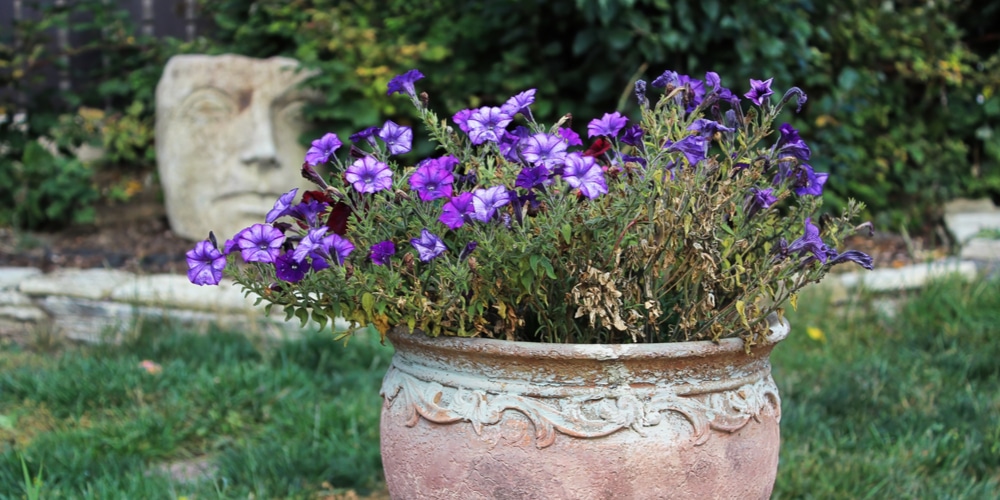Why Are My Petunias Turning Yellow – Petunias are a beloved choice among gardeners due to their vibrant colors and long-lasting blooms. However, many petunia owners face a common dilemma: their beautiful plants start turning yellow. This can be disheartening, especially when you have invested time, effort, and love into nurturing these flowers. Understanding the reasons behind the yellowing leaves is essential for maintaining the health of your petunias and ensuring they flourish. In this article, we will explore the various factors that cause petunias to turn yellow, how to identify the underlying problems, and what steps you can take to bring your petunias back to life.
Common Causes of Yellowing Petunias
There are several reasons your petunias might be turning yellow. Let’s break them down:
1. Overwatering 🚰

One of the most common reasons petunias turn yellow is overwatering. Petunias thrive in well-draining soil, and excessive moisture can lead to root rot and other issues.
- Symptoms: Yellowing leaves, wilting, and a foul smell from the soil.
- Solution: Allow the soil to dry out between waterings. Ensure proper drainage in your pots or garden bed.
2. Nutrient Deficiency 🌱
A lack of essential nutrients, particularly nitrogen, can cause petunias to display yellow leaves. Petunias require balanced fertilization to stay healthy.
- Symptoms: Older leaves yellowing first, with new growth appearing stunted.
- Solution: Apply a balanced fertilizer high in nitrogen. A slow-release fertilizer is ideal for long-term health.
3. Pests Infestation 🐞
Common pests such as aphids and spider mites can sap the vitality from your petunias, resulting in yellowing leaves. These pests can also create sticky residue and webs that can hinder growth.
- Symptoms: Yellowing leaves, visible insects, and sticky residue on leaves.
- Solution: Regularly inspect your plants and treat infestations promptly with insecticidal soap or neem oil.
4. Fungal Diseases
Fungal infections such as powdery mildew can lead to yellow leaves and affect the overall health of your petunias.
- Symptoms: White powdery substance on leaves, yellowing, and leaf drop.
- Solution: Ensure proper air circulation, avoid overhead watering, and treat with appropriate fungicides.
5. Environmental Stress
Changes in the environment, such as sudden temperature fluctuations or excessive heat, can stress petunias and lead to yellowing leaves.
- Symptoms: Leaves turning yellow and crispy edges.
- Solution: Provide adequate shade during extreme heat and ensure consistent watering during cold spells.
How to Diagnose the Problem: Why Are My Petunias Turning Yellow
Diagnosing the cause of yellowing petunias involves careful observation and testing. Here’s a simple checklist to follow:
| Symptoms | Possible Cause | Suggested Action |
|---|---|---|
| Yellowing leaves with wilting | Overwatering | Check drainage and reduce watering |
| Stunted growth, yellowing older leaves | Nutrient deficiency | Apply fertilizer high in nitrogen |
| Visible pests on leaves | Pest infestation | Treat with insecticidal soap or neem oil |
| White powdery substance, yellowing leaves | Fungal disease | Improve air circulation, apply fungicide |
| Crispy edges on leaves, yellowing | Environmental stress | Provide shade, consistent watering |
Preventive Measures for Healthy Petunias
Preventing yellowing in petunias involves proactive care. Here are several tips to ensure your petunias stay vibrant and healthy:
1. Proper Watering Techniques
Water your petunias only when the top inch of soil feels dry. Use a moisture meter or stick your finger into the soil to check moisture levels. This helps prevent overwatering while ensuring they receive enough hydration.
2. Balanced Fertilization
Apply a balanced fertilizer every four to six weeks during the growing season. This ensures your petunias receive the necessary nutrients for growth and blooming. Consider using organic options for a more sustainable approach.
3. Regular Pest Checks, Why Are My Petunias Turning Yellow
Make it a habit to inspect your petunias for pests at least once a week. Catching pests early can prevent significant damage. You can use natural repellents like garlic or neem oil to deter pests without harming your plants.
4. Disease Management
Practice good hygiene in your garden. Remove any dead or diseased foliage promptly. Ensure you have good air circulation around your plants, which can help prevent fungal infections. Water at the base of the plant to avoid wetting the foliage.
5. Environmental Adjustments
Be aware of local weather conditions and prepare for them. If a heatwave is coming, consider providing shade or mulch around your petunias to retain soil moisture and keep roots cool. For chilly nights, use protective coverings to shield them from the cold.
When to Seek Help
If you’ve tried all the above measures and your petunias are still turning yellow, it might be time to consult a local gardening expert or extension service. They can provide tailored advice based on your region, plant variety, and specific conditions.
Remember, yellowing leaves can be an early warning sign. Acting promptly can save your petunias and ensure they bloom beautifully throughout the season! 🌼
Frequently Asked Questions

1. How do I know if my petunias are overwatered?
Signs of overwatering include yellowing leaves, wilting despite wet soil, and a foul smell coming from the soil. Always ensure your pots have drainage holes.
2. Can yellowing leaves recover?
Yes! If addressed early, yellowing leaves can return to health. Ensure proper care and conditions, and the plant can bounce back.
3. Are yellow petunias a sign of something serious?
Not necessarily. Yellowing can often be corrected with proper care. However, persistent yellowing can indicate deeper issues that may require professional help.
4. How often should I fertilize my petunias?
During the growing season, it’s best to fertilize petunias every four to six weeks to maintain optimal health and blooming potential.
Final Thoughts on Petunia Care
Yellowing petunias can be frustrating, but with careful observation and proactive care, you can restore their vibrant glory. Pay attention to watering practices, nutrient needs, and potential pest infestations. By doing so, you’ll not only enjoy healthier petunias but also gain valuable gardening experience. Happy gardening! 🌻
